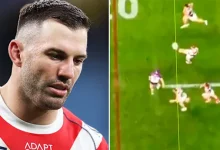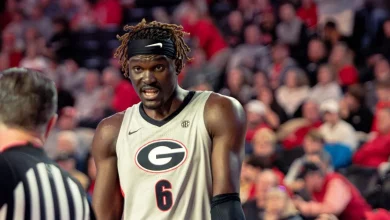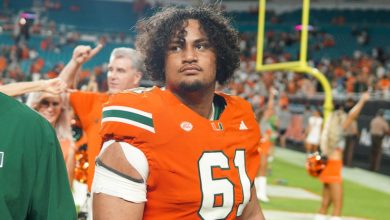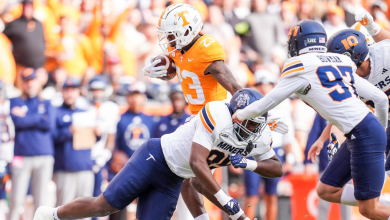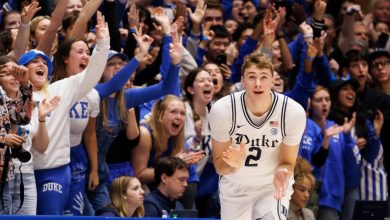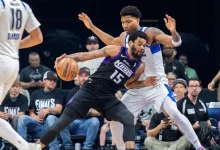The Navy Midshipmen’s Contributions to the Armed Forces Bowl Victory Over the Oklahoma Sooners
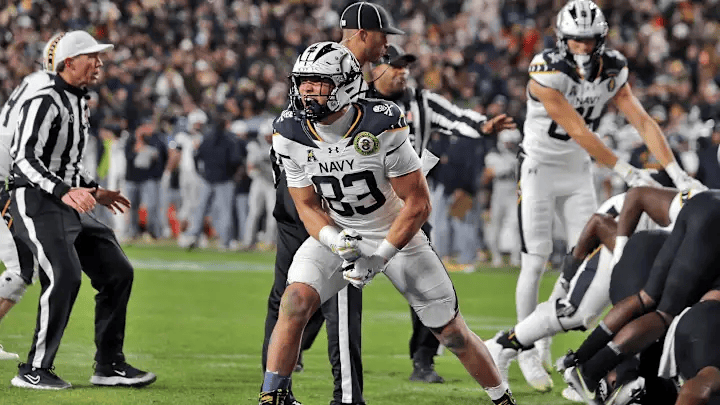
The Navy Midshipmen’s Contributions to the Armed Forces Bowl Victory Over the Oklahoma Sooners
In the world of college football, the Armed Forces Bowl is one of the most exciting and meaningful games of the postseason. The 2024 edition of the Armed Forces Bowl was no different, with the Navy Midshipmen securing a hard-fought victory over the Oklahoma Sooners. This victory was not just a triumph of athletic skill and teamwork, but also a testament to the spirit, resilience, and commitment of the Navy football program, which embodies values of service, sacrifice, and honor that go beyond the football field.
For Navy, the victory over Oklahoma in the Armed Forces Bowl represented not only a significant achievement for the team but also a display of their ability to execute a disciplined and strategic game plan against a formidable opponent. The Midshipmen’s win was marked by a series of crucial contributions from key players, effective coaching, and the relentless dedication to their system of play. From their powerful running game to timely defensive plays, Navy’s victory was a team effort, and each facet of their game played a role in securing the 2024 Armed Forces Bowl championship.
This article takes a closer look at the Navy Midshipmen’s contributions to their historic victory over the Oklahoma Sooners, analyzing the key moments, standout performances, and tactical decisions that led to their triumph.
The Navy Midshipmen: A Team Built on Discipline and Tradition
The Navy football program has long been known for its disciplined approach to the game. As one of the military academies in the United States, Navy’s football team plays with a distinct sense of duty and tradition, mirroring the values instilled in their student-athletes. The Midshipmen’s commitment to hard work, sacrifice, and teamwork is evident in everything they do, both on and off the field. Their triple-option offense, which relies heavily on execution, timing, and precision, is a reflection of the meticulous planning and coordination that defines the program.
Navy’s offensive scheme is a unique blend of traditional power football and clock control, designed to wear down opponents physically and mentally. This methodical approach ensures that Navy stays competitive, even against more traditionally powerful teams like Oklahoma. The Armed Forces Bowl was a perfect stage for the Midshipmen to showcase their strengths, and they did so with poise and determination.
The Triple-Option Offense: The Heart of Navy’s Attack
One of the defining features of Navy’s football program is its triple-option offense. Unlike the spread offenses or pro-style systems commonly seen in college football, the triple option is a run-heavy, ball-control strategy that places a premium on execution and precision. The offense relies on quick decision-making by the quarterback, often making the defense account for multiple potential ball carriers on each play. The effectiveness of the triple-option system comes from its ability to create mismatches in the open field and keep opposing defenses on their heels.
In the Armed Forces Bowl, Navy’s triple-option offense was on full display. The offensive line, often unheralded in the context of other college football programs, was key in controlling the line of scrimmage and allowing the Midshipmen to dictate the pace of the game. Navy’s quarterback, who operates as the focal point of the option attack, made smart reads, deftly faking handoffs and choosing when to keep the ball or pitch it to the running back. This fluidity and execution allowed Navy to move the ball efficiently against Oklahoma’s defense.
Navy’s running back corps, one of the strongest in the country, capitalized on the offensive line’s dominance, constantly pushing forward for positive yardage. These backs, who are trained to run with discipline and toughness, made it difficult for the Sooners’ defense to stop the Midshipmen’s ground attack. Oklahoma’s defensive front, despite their size and athleticism, found themselves consistently outmatched as Navy methodically moved the chains.
The triple-option offense is not only about running the ball but also about clock management. By controlling the ball and eating up clock, Navy kept Oklahoma’s high-powered offense off the field for extended periods. This strategic element of the game allowed Navy to wear down the Sooners’ defense while keeping their own defense fresh. It was a perfect example of how a disciplined, methodical offensive approach could be just as effective as a high-octane passing attack, especially in a bowl game where control of the tempo is vital.
Standout Performances: Key Players Make Their Mark
While the entire Navy team contributed to the victory, several players stood out as key contributors to the team’s success in the Armed Forces Bowl. Their performances highlighted the impact of individual effort combined with the strength of the team’s overall system.
1. Quarterback Tai Lavatai
Quarterback Tai Lavatai, the leader of Navy’s triple-option offense, was instrumental in orchestrating the victory. His ability to read the defense, make quick decisions, and execute the option plays to perfection was a critical factor in Navy’s success. Lavatai showed poise under pressure and delivered key plays when the team needed them most. His quickness and agility allowed him to evade Oklahoma’s defenders and gain valuable yards on the ground, while his decision-making kept the Sooners’ defense guessing on each play.
Lavatai’s ability to manage the game and make crucial throws when necessary also helped Navy extend drives and keep the Sooners’ defense off balance. Though Navy’s offense is largely run-based, Lavatai’s performance proved that the Midshipmen could be dangerous in the passing game as well, adding another layer to their already formidable attack.
2. Running Back Anton Hall Jr.
Anton Hall Jr. was another standout performer in the Armed Forces Bowl. As one of Navy’s primary running backs, Hall was instrumental in keeping the chains moving throughout the game. His vision, balance, and ability to break tackles were on full display as he accumulated significant yardage on the ground. Hall’s physical running style wore down the Oklahoma defense, enabling Navy to control the tempo of the game and dictate the pace of play.
Hall’s contributions were not just limited to his rushing yards; he also displayed excellent ball security, which was crucial in a game where turnovers could have been detrimental. His ability to churn out yards and maintain possession allowed Navy to dominate time of possession, a critical factor in limiting Oklahoma’s opportunities to score.
3. Navy’s Offensive Line
The offensive line is often the unsung hero in any football game, and the Armed Forces Bowl was no exception. Navy’s offensive line, known for its size, strength, and cohesion, played a pivotal role in the team’s victory. Against a powerful Oklahoma defensive line, Navy’s blockers were able to create running lanes and give Lavatai the time and space he needed to execute the triple-option offense.
The Midshipmen’s offensive line showcased its depth and versatility, controlling the line of scrimmage and wearing down Oklahoma’s defenders. The offensive line’s dominance allowed Navy to sustain long drives, control the game clock, and keep the Sooners’ offense off the field for critical stretches. In a game that relied so heavily on ball control and field position, the performance of Navy’s offensive line was nothing short of essential to their success.
4. Defensive Playmakers: The Unsung Heroes
While Navy’s offense garnered much of the attention, the team’s defense played a critical role in the victory. Navy’s defense, known for its aggressive, disciplined approach, was able to stifle Oklahoma’s potent offense, forcing the Sooners into unfavorable situations throughout the game.
The Midshipmen’s defensive front, led by standout players such as linebacker John Marshall and defensive linemen Jacob Thomas and Noah Wofford, applied constant pressure on Oklahoma’s quarterbacks, disrupting the Sooners’ offensive rhythm. Navy’s defensive backs were equally impressive, keeping Oklahoma’s receivers in check and forcing several key turnovers.
Navy’s ability to force Oklahoma into third-and-long situations and make stops in critical moments allowed the Midshipmen to maintain control of the game. By limiting the Sooners’ offensive production and forcing them into mistakes, Navy’s defense ensured that the Midshipmen could continue to build on their offensive success and eventually secure the win.
Coaching: Strategy and Adaptation
Head coach Ken Niumatalolo and his staff deserve considerable credit for the game plan and adjustments made throughout the contest. Niumatalolo, one of the most respected coaches in college football, has built a program at Navy that thrives on discipline, preparation, and adaptability. His leadership was instrumental in Navy’s performance in the Armed Forces Bowl.
Niumatalolo’s strategic decisions, such as controlling the clock with long, methodical drives, played a significant role in keeping Oklahoma off balance. The ability to adjust the game plan based on the flow of the game, while sticking to the principles of Navy’s triple-option offense, was a key reason for the Midshipmen’s success. Moreover, Niumatalolo’s experience in big-game situations allowed him to guide his team through critical moments, making the necessary adjustments to counter Oklahoma’s strengths.

